狄更斯小说中儿童形象分析
- 格式:doc
- 大小:29.00 KB
- 文档页数:9
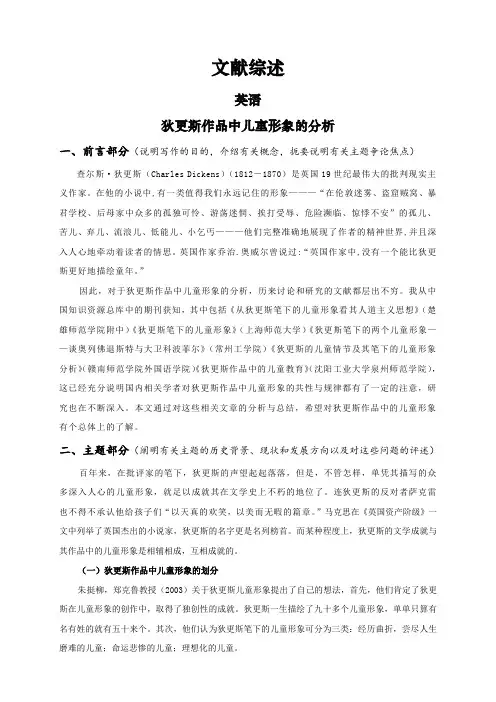
文献综述英语狄更斯作品中儿童形象的分析一、前言部分(说明写作的目的,介绍有关概念,扼要说明有关主题争论焦点)查尔斯·狄更斯(Charles Dickens)(1812-1870)是英国19世纪最伟大的批判现实主义作家。
在他的小说中,有一类值得我们永远记住的形象———“在伦敦迷雾、盗窟贼窝、暴君学校、后母家中众多的孤独可怜、游荡迷惘、挨打受辱、危险濒临、惊悸不安”的孤儿、苦儿、弃儿、流浪儿、低能儿、小乞丐———他们完整准确地展现了作者的精神世界,并且深入人心地牵动着读者的情思。
英国作家乔治.奥威尔曾说过:“英国作家中,没有一个能比狄更斯更好地描绘童年。
”因此,对于狄更斯作品中儿童形象的分析,历来讨论和研究的文献都层出不穷。
我从中国知识资源总库中的期刊获知,其中包括《从狄更斯笔下的儿童形象看其人道主义思想》(楚雄师范学院附中)《狄更斯笔下的儿童形象》(上海师范大学)《狄更斯笔下的两个儿童形象——谈奥列佛退斯特与大卫科波菲尔》(常州工学院)《狄更斯的儿童情节及其笔下的儿童形象分析》(赣南师范学院外国语学院)《狄更斯作品中的儿童教育》(沈阳工业大学泉州师范学院),这已经充分说明国内相关学者对狄更斯作品中儿童形象的共性与规律都有了一定的注意,研究也在不断深入。
本文通过对这些相关文章的分析与总结,希望对狄更斯作品中的儿童形象有个总体上的了解。
二、主题部分(阐明有关主题的历史背景、现状和发展方向以及对这些问题的评述)百年来,在批评家的笔下,狄更斯的声望起起落落,但是,不管怎样,单凭其描写的众多深入人心的儿童形象,就足以成就其在文学史上不朽的地位了。
连狄更斯的反对者萨克雷也不得不承认他给孩子们“以天真的欢笑,以美而无暇的篇章。
”马克思在《英国资产阶级》一文中列举了英国杰出的小说家,狄更斯的名字更是名列榜首。
而某种程度上,狄更斯的文学成就与其作品中的儿童形象是相辅相成,互相成就的。
(一)狄更斯作品中儿童形象的划分朱挺柳,郑克鲁教授(2003)关于狄更斯儿童形象提出了自己的想法,首先,他们肯定了狄更斯在儿童形象的创作中,取得了独创性的成就。
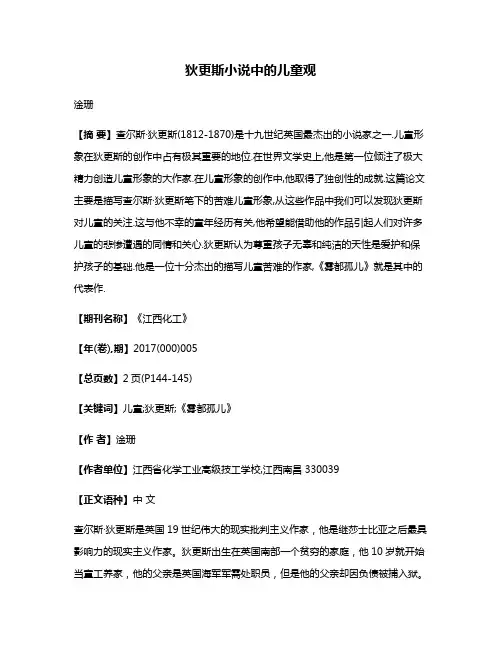
狄更斯小说中的儿童观淦珊【摘要】查尔斯·狄更斯(1812-1870)是十九世纪英国最杰出的小说家之一.儿童形象在狄更斯的创作中占有极其重要的地位.在世界文学史上,他是第一位倾注了极大精力创造儿童形象的大作家.在儿童形象的创作中,他取得了独创性的成就.这篇论文主要是描写查尔斯·狄更斯笔下的苦难儿童形象,从这些作品中我们可以发现狄更斯对儿童的关注.这与他不幸的童年经历有关,他希望能借助他的作品引起人们对许多儿童的悲惨遭遇的同情和关心.狄更斯认为尊重孩子无辜和纯洁的天性是爱护和保护孩子的基础.他是一位十分杰出的描写儿童苦难的作家,《雾都孤儿》就是其中的代表作.【期刊名称】《江西化工》【年(卷),期】2017(000)005【总页数】2页(P144-145)【关键词】儿童;狄更斯;《雾都孤儿》【作者】淦珊【作者单位】江西省化学工业高级技工学校,江西南昌330039【正文语种】中文查尔斯·狄更斯是英国19世纪伟大的现实批判主义作家,他是继莎士比亚之后最具影响力的现实主义作家。
狄更斯出生在英国南部一个贫穷的家庭,他10岁就开始当童工养家,他的父亲是英国海军军需处职员,但是他的父亲却因负债被捕入狱。
狄更斯生活的巨变发生在他12岁那一年。
为了节省开支,狄更斯一家全部迁入监狱,只有狄更斯在外工作,当他领到薪水时,他会带着食物去监狱探望家人们。
在他的父亲重获自由之后,狄更斯进入一间私立学校学习。
然而他认为学校里粗暴的教育会毁了儿童。
狄更斯做过各种各样的工作,例如:律师事务所的学徒,办公室通讯员以及审案速记员。
他在1832年成为了一名报社记者,为他将来的写作生涯积累了许多生活素材。
狄更斯终于1870年6月9日。
狄更斯在《雾都孤儿》第一版的序言中写道:我相信我是每个孩子都喜欢的父母,没人能像我一样爱着他们,但是像所有父母一样,在我心中有一个最爱的孩子,他的名字就叫《雾都孤儿》。
这部作品中的主人公奥利弗是一个富裕家庭的私生子,他在这个冰冷的世界遭遇了许多曲折。
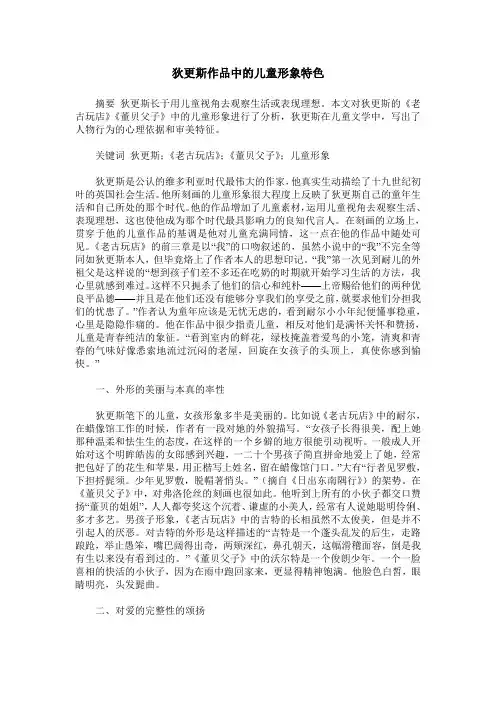
狄更斯作品中的儿童形象特色摘要狄更斯长于用儿童视角去观察生活或表现理想。
本文对狄更斯的《老古玩店》《董贝父子》中的儿童形象进行了分析,狄更斯在儿童文学中,写出了人物行为的心理依据和审美特征。
关键词狄更斯;《老古玩店》;《董贝父子》;儿童形象狄更斯是公认的维多利亚时代最伟大的作家,他真实生动描绘了十九世纪初叶的英国社会生活。
他所刻画的儿童形象很大程度上反映了狄更斯自己的童年生活和自己所处的那个时代。
他的作品增加了儿童素材,运用儿童视角去观察生活、表现理想,这也使他成为那个时代最具影响力的良知代言人。
在刻画的立场上,贯穿于他的儿童作品的基调是他对儿童充满同情,这一点在他的作品中随处可见。
《老古玩店》的前三章是以“我”的口吻叙述的,虽然小说中的“我”不完全等同如狄更斯本人,但毕竟烙上了作者本人的思想印记。
“我”第一次见到耐儿的外祖父是这样说的“想到孩子们差不多还在吃奶的时期就开始学习生活的方法,我心里就感到难过。
这样不只扼杀了他们的信心和纯朴——上帝赐给他们的两种优良平品德——并且是在他们还没有能够分享我们的享受之前,就要求他们分担我们的忧患了。
”作者认为童年应该是无忧无虑的,看到耐尔小小年纪便懂事稳重,心里是隐隐作痛的。
他在作品中很少指责儿童,相反对他们是满怀关怀和赞扬,儿童是青春纯洁的象征。
“看到室内的鲜花,绿枝掩盖着爱鸟的小笼,清爽和青春的气味好像悉索地流过沉闷的老屋,回旋在女孩子的头顶上,真使你感到愉快。
”一、外形的美丽与本真的率性狄更斯笔下的儿童,女孩形象多半是美丽的。
比如说《老古玩店》中的耐尔,在蜡像馆工作的时候,作者有一段对她的外貌描写。
“女孩子长得很美,配上她那种温柔和怯生生的态度,在这样的一个乡僻的地方很能引动视听。
一般成人开始对这个明眸皓齿的女郎感到兴趣,一二十个男孩子简直拼命地爱上了她,经常把包好了的花生和苹果,用正楷写上姓名,留在蜡像馆门口。
”大有“行者见罗敷,下担捋髭须。
少年见罗敷,脱帽著悄头。

狄更斯笔下的儿童形象英国伟大的批判现实主义作家查尔斯・狄更斯在塑造的各色人物形象当中,儿童形象是作家组织故事脉络的中心,他们身上带有作家童年时代饱受凌辱和摧残经历的影子,被作家寄予了无限的希望,他们的身上折射出作家的人道主义思想光辉,成为了狄更斯小说作品中最为闪亮的部分。
本文将从狄更斯本人的童年经历入手,深入分析狄更斯作品中儿童形象的特点。
19世纪的英国,正是工业革命完成、英国走向强大的资本主义工业强国的重要时期。
庞大的英吉利帝国在全球各地占据殖民地,号称日不落帝国,是英帝国的全盛时期。
也正是由于中产阶层和工人阶级的兴起,英国人改变了立法、选举等各方面的制度,资产阶级国家的雏形逐步形成,资产阶级在社会生活中的地位不断提高。
但是在经济快速发展的同时,英国社会产生了大量的社会问题,特别是工业化过程中,资产阶级和工人阶级从过去的利益共享的关系逐渐演变为由于经济利益分配不均而产生的对立阶级。
机械生产地位的逐步提高更使得工人逐渐由生产的主体沦为机器的附属。
对经济利益的追求使得资产阶级企业家想法设法地盘剥工人,甚至雇用大量妇女和童工以压低成本,同时却不能保障工人的生命安全,工伤事故不断,特别是童工的待遇极差,严重影响了儿童的身心成长。
可以说,这是一个最好的时代,这是一个最坏的时代。
在这样的背景之下,狄更斯的作品向受苦受难的儿童投去慈爱的目光,同时揭露社会的黑暗和不公,展现了其人道主义思想。
与狄更斯笔下的很多儿童形象一样,狄更斯的童年经历是十分悲惨坎坷的。
狄更斯出生在英国朴茨茅斯的波特西地区,他的家庭十分贫困,父亲原是海军中一个小职员,依靠微薄的薪水支撑全家的开销,由于子女众多,家庭逐渐开始入不敷出,依靠借债勉强度日。
后来,狄更斯一家辗转迁居伦敦和查坦木,父亲更是因为负债无力偿还,在狄更斯10岁这年全家被关进马夏西债务监狱,这无疑对狄更斯产生了极为深远的影响。
为了谋生,他12岁时出外寻求工作机会,挑起了维持家庭生活的重担,他在一家皮鞋油作坊当上了童工,依靠在当街的玻璃窗中劳动当活广告挣钱养家糊口。
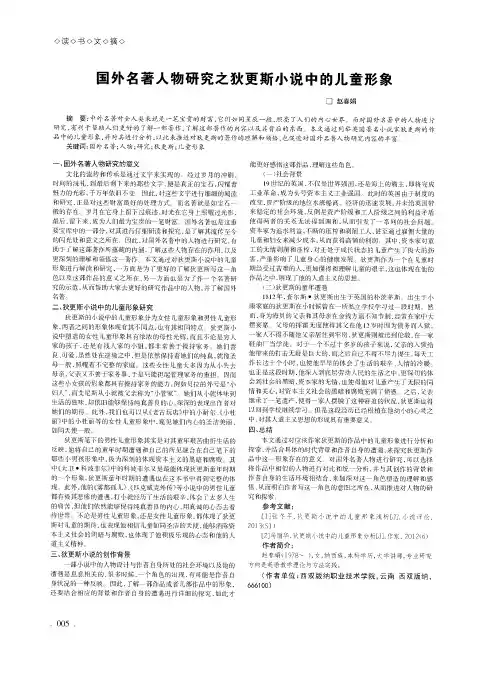
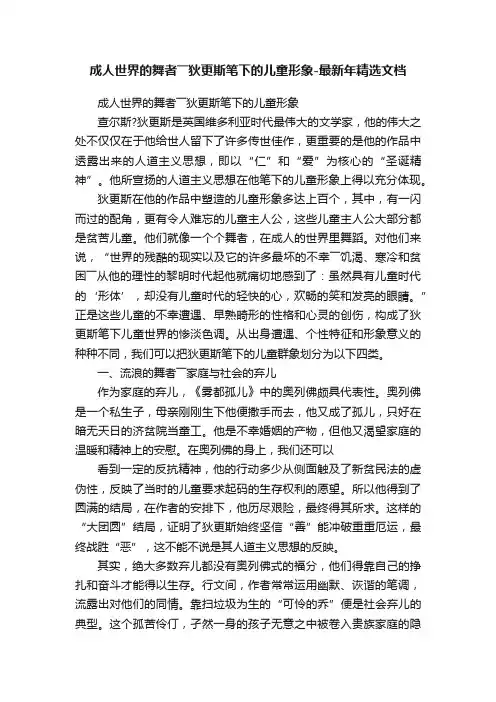
成人世界的舞者――狄更斯笔下的儿童形象-最新年精选文档成人世界的舞者――狄更斯笔下的儿童形象查尔斯?狄更斯是英国维多利亚时代最伟大的文学家,他的伟大之处不仅仅在于他给世人留下了许多传世佳作,更重要的是他的作品中透露出来的人道主义思想,即以“仁”和“爱”为核心的“圣诞精神”。
他所宣扬的人道主义思想在他笔下的儿童形象上得以充分体现。
狄更斯在他的作品中塑造的儿童形象多达上百个,其中,有一闪而过的配角,更有令人难忘的儿童主人公,这些儿童主人公大部分都是贫苦儿童。
他们就像一个个舞者,在成人的世界里舞蹈。
对他们来说,“世界的残酷的现实以及它的许多最坏的不幸――饥渴、寒冷和贫困――从他的理性的黎明时代起他就痛切地感到了:虽然具有儿童时代的‘形体’,却没有儿童时代的轻快的心,欢畅的笑和发亮的眼睛。
”正是这些儿童的不幸遭遇、早熟畸形的性格和心灵的创伤,构成了狄更斯笔下儿童世界的惨淡色调。
从出身遭遇、个性特征和形象意义的种种不同,我们可以把狄更斯笔下的儿童群象划分为以下四类。
一、流浪的舞者――家庭与社会的弃儿作为家庭的弃儿,《雾都孤儿》中的奥列佛颇具代表性。
奥列佛是一个私生子,母亲刚刚生下他便撒手而去,他又成了孤儿,只好在暗无天日的济贫院当童工。
他是不幸婚姻的产物,但他又渴望家庭的温暖和精神上的安慰。
在奥列佛的身上,我们还可以看到一定的反抗精神,他的行动多少从侧面触及了新贫民法的虚伪性,反映了当时的儿童要求起码的生存权利的愿望。
所以他得到了圆满的结局,在作者的安排下,他历尽艰险,最终得其所求。
这样的“大团圆”结局,证明了狄更斯始终坚信“善”能冲破重重厄运,最终战胜“恶”,这不能不说是其人道主义思想的反映。
其实,绝大多数弃儿都没有奥列佛式的福分,他们得靠自己的挣扎和奋斗才能得以生存。
行文间,作者常常运用幽默、诙谐的笔调,流露出对他们的同情。
靠扫垃圾为生的“可怜的乔”便是社会弃儿的典型。
这个孤苦伶仃,孑然一身的孩子无意之中被卷入贵族家庭的隐私,遭到警察的驱赶,甚至贫民窟都不容他栖身。
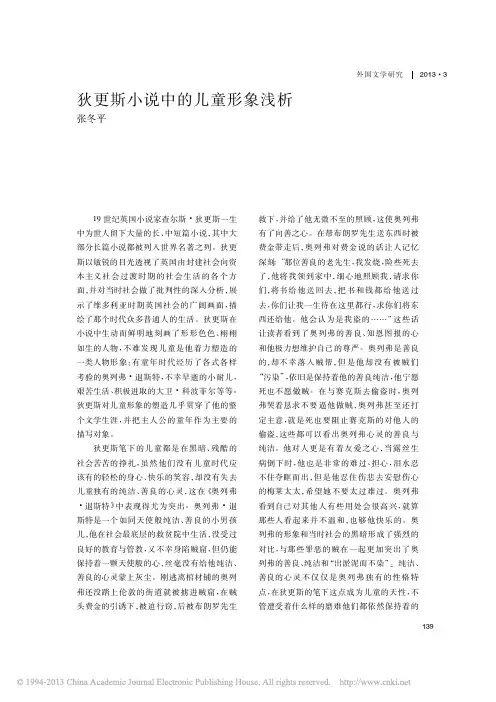
外国文学研究2013·3狄更斯小说中的儿童形象浅析张冬平19世纪英国小说家查尔斯·狄更斯一生中为世人留下大量的长、中短篇小说,其中大部分长篇小说都被列入世界名著之列。
狄更斯以敏锐的目光透视了英国由封建社会向资本主义社会过渡时期的社会生活的各个方面,并对当时社会做了批判性的深入分析,展示了维多利亚时期英国社会的广阔画面,描绘了那个时代众多普通人的生活。
狄更斯在小说中生动而鲜明地刻画了形形色色、栩栩如生的人物,不难发现儿童是他着力塑造的一类人物形象:有童年时代经历了各式各样考验的奥列弗·退斯特,不幸早逝的小耐儿,艰苦生活、积极进取的大卫·科波菲尔等等。
狄更斯对儿童形象的塑造几乎贯穿了他的整个文学生涯,并把主人公的童年作为主要的描写对象。
狄更斯笔下的儿童都是在黑暗、残酷的社会苦苦的挣扎,虽然他们没有儿童时代应该有的轻松的身心、快乐的笑容,却没有失去儿童独有的纯洁、善良的心灵,这在《奥列弗·退斯特》中表现得尤为突出。
奥列弗·退斯特是一个如同天使般纯洁、善良的小男孩儿,他在社会最底层的救贫院中生活,没受过良好的教育与管教,又不幸身陷贼窟,但仍能保持着一颗天使般的心,丝毫没有给他纯洁、善良的心灵蒙上灰尘。
刚逃离棺材铺的奥列弗还没踏上伦敦的街道就被掳进贼窟,在贼头费金的引诱下,被迫行窃,后被布朗罗先生救下,并给了他无微不至的照顾,这使奥列弗有了向善之心。
在帮布朗罗先生送东西时被费金带走后,奥列弗对费金说的话让人记忆深刻:“那位善良的老先生,我发烧,险些死去了,他将我领到家中,细心地照顾我,请求你们,将书给他送回去,把书和钱都给他送过去,你们让我一生待在这里都行,求你们将东西还给他。
他会认为是我盗的……”这些话让读者看到了奥列弗的善良、知恩图报的心和他极力想维护自己的尊严。
奥列弗是善良的,却不幸落入贼帮,但是他却没有被贼们“污染”,依旧是保持着他的善良纯洁,他宁愿死也不愿做贼。
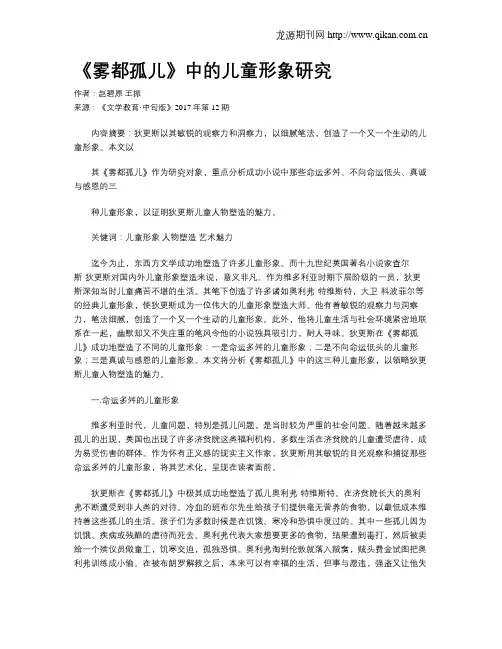
《雾都孤儿》中的儿童形象研究作者:赵碧原王振来源:《文学教育·中旬版》2017年第12期内容摘要:狄更斯以其敏锐的观察力和洞察力,以细腻笔法,创造了一个又一个生动的儿童形象。
本文以其《雾都孤儿》作为研究对象,重点分析成功小说中那些命运多舛、不向命运低头、真诚与感恩的三种儿童形象,以证明狄更斯儿童人物塑造的魅力。
关健词:儿童形象人物塑造艺术魅力迄今为止,东西方文学成功地塑造了许多儿童形象。
而十九世纪英国著名小说家查尔斯·狄更斯对国内外儿童形象塑造来说,意义非凡。
作为维多利亚时期下层阶级的一员,狄更斯深知当时儿童痛苦不堪的生活。
其笔下创造了许多诸如奥利弗·特维斯特,大卫·科波菲尔等的经典儿童形象,使狄更斯成为一位伟大的儿童形象塑造大师。
他有着敏锐的观察力与洞察力,笔法细腻,创造了一个又一个生动的儿童形象。
此外,他将儿童生活与社会环境紧密地联系在一起,幽默却又不失庄重的笔风令他的小说独具吸引力,耐人寻味。
狄更斯在《雾都孤儿》成功地塑造了不同的儿童形象:一是命运多舛的儿童形象;二是不向命运低头的儿童形象;三是真诚与感恩的儿童形象。
本文将分析《雾都孤儿》中的这三种儿童形象,以领略狄更斯儿童人物塑造的魅力。
一.命运多舛的儿童形象维多利亚时代,儿童问题,特别是孤儿问题,是当时较为严重的社会问题。
随着越来越多孤儿的出现,英国也出现了许多济贫院这类福利机构。
多数生活在济贫院的儿童遭受虐待,成为易受伤害的群体。
作为怀有正义感的现实主义作家,狄更斯用其敏锐的目光观察和捕捉那些命运多舛的儿童形象,将其艺术化,呈现在读者面前。
狄更斯在《雾都孤儿》中极其成功地塑造了孤儿奥利弗·特维斯特。
在济贫院长大的奥利弗不断遭受到非人类的对待。
冷血的班布尔先生给孩子们提供毫无营养的食物,以最低成本维持着这些孤儿的生活。
孩子们为多数时候是在饥饿、寒冷和恐惧中度过的。
其中一些孤儿因为饥饿、疾病或残酷的虐待而死去。
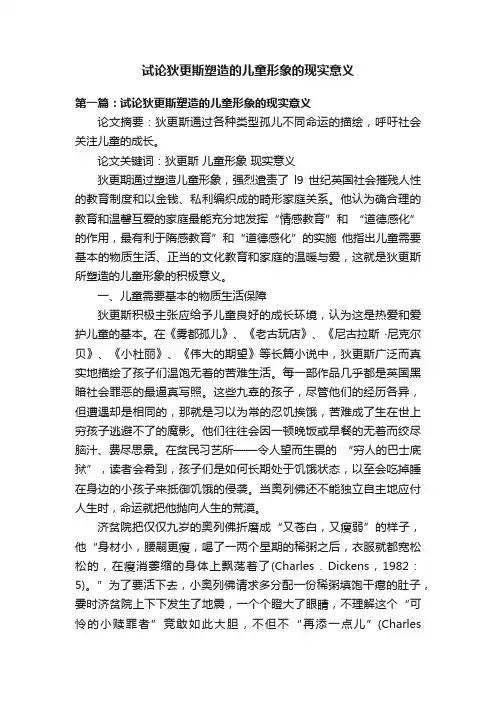
试论狄更斯塑造的儿童形象的现实意义第一篇:试论狄更斯塑造的儿童形象的现实意义论文摘要:狄更斯通过各种类型孤儿不同命运的描绘,呼吁社会关注儿童的成长。
论文关键词:狄更斯儿童形象现实意义狄更期通过塑造儿童形象,强烈遣责了l9世纪英国社会摧残人性的教育制度和以金钱、私利编织成的畸形家庭关系。
他认为确合理的教育和温馨互爱的家庭最能充分地发挥“情感教育”和“道德感化”的作用,最有利于隋感教育”和“道德感化”的实施他指出儿童需要基本的物质生活、正当的文化教育和家庭的温暖与爱,这就是狄更斯所塑造的儿童形象的积极意义。
一、儿童需要基本的物质生活保障狄更斯积极主张应给予儿童良好的成长环境,认为这是热爱和爱护儿童的基本。
在《雾都孤儿》、《老古玩店》、《尼古拉斯·尼克尔贝》、《小杜丽》、《伟大的期望》等长篇小说中,狄更斯广泛而真实地描绘了孩子们温饱无着的苦难生活。
每一部作品几乎都是英国黑暗社会罪恶的最逼真写照。
这些九辜的孩子,尽管他们的经历各异,但遭遇却是相同的,那就是习以为常的忍饥挨饿,苦难成了生在世上穷孩子逃避不了的魔影。
他们往往会因一顿晚饭或早餐的无着而绞尽脑汁、费尽思景。
在贫民习艺所——令人望而生畏的“穷人的巴士底狱”,读者会肴到,孩子们是如何长期处于饥饿状态,以至会吃掉睡在身边的小孩子来抵御饥饿的侵袭。
当奥列佛还不能独立自主地应付人生时,命运就把他抛向人生的荒漠。
济贫院把仅仅九岁的奥列佛折磨成“又苍白,又瘦弱”的样子,他“身材小,腰嗣更瘦,喝了一两个星期的稀粥之后,衣服就都宽松松的,在瘦消萎缩的身体上飘荡着了(Charles.Dickens,1982:5)。
”为了要活下去,小奥列佛请求多分配一份稀粥填饱干瘪的肚子,霎时济贫院上下下发生了地震,一个个瞪大了眼睛,不理解这个“可怜的小赎罪者”竞敢如此大胆,不但不“再添一点儿”(CharlesDickens,1982:l2-l3),反而尢情地处分他。
在《雾都孤儿》中,狄更斯还塑造了一系列这样的孤儿形象。
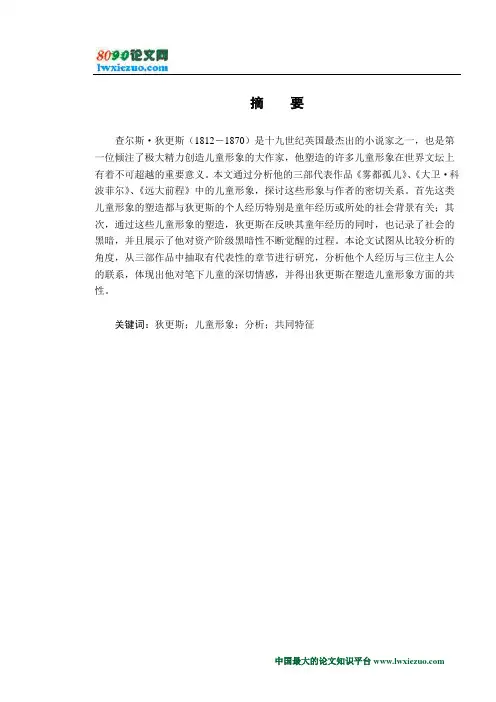
摘要查尔斯·狄更斯(1812-1870)是十九世纪英国最杰出的小说家之一,也是第一位倾注了极大精力创造儿童形象的大作家,他塑造的许多儿童形象在世界文坛上有着不可超越的重要意义。
本文通过分析他的三部代表作品《雾都孤儿》、《大卫·科波菲尔》、《远大前程》中的儿童形象,探讨这些形象与作者的密切关系。
首先这类儿童形象的塑造都与狄更斯的个人经历特别是童年经历或所处的社会背景有关;其次,通过这些儿童形象的塑造,狄更斯在反映其童年经历的同时,也记录了社会的黑暗,并且展示了他对资产阶级黑暗性不断觉醒的过程。
本论文试图从比较分析的角度,从三部作品中抽取有代表性的章节进行研究,分析他个人经历与三位主人公的联系,体现出他对笔下儿童的深切情感,并得出狄更斯在塑造儿童形象方面的共性。
关键词:狄更斯;儿童形象;分析;共同特征ABSTRACTCharles Dickens(1812-1870)is one of the most outstanding English writers in the nineteenth century. He is also the first writer who devoted himself to the creation of children‘ imagines. The images of children created by Charles Dickens play a very important role in the world literature. By comparison, this paper discusses the relationship between the author and these images. Firstl y, the creation of these children‘s images has a close connection with Dickens‘ personal experience and social background; secondly, by the creation of these images he reveals the darkness of society, and shows his growing awareness of the darkness of the capitalism. Through the analysis, this paper draws the common features in Charles‘ creation of children‘s imagines. And through the research of the representative chapters, the deep emotions between Dickens and his children can be vividly shown.Keywords:Dickens; Children‘s images; Analysis; Common FeaturesContents1. Introduction (1)1.1The introduction of the author (1)1.2The introduction of children‘s images (1)2. Analysis of the three main children’s images in Dickens’ novels (3)2.1Oliver Twist: Dickens‘ own want in his childhood (3)2.2David Copperfield: Dickens‘ own sufferings in his childhood (5)2.3Great Expectations: Dickens‘ growing awareness of c apitalism‘s darkness (7)3. The comparison of three children’s images in three novels (10)3.1 The similarities of the three children (10)3.1.1 The circumstances (10)3.1.2 The tragedy childhood (10)3.2 The relationship between Dickens and the three children (11)3.2.1 The similar childhood experiences (11)3.2.2 The sympathy for the children and the criticism for social evils (11)3.2.3 The common styles in children‘s images figuring (12)4. Conclusion (13)Acknowledgements (14)References (15)1. Introduction1.1 The Introduction of the AuthorCharles Dickens(1812-1870)is one of the most outstanding English writers in the nineteenth century. He was born in Portsmouth, England on 7th, February, 1812, but he spent most of his childhood in London and Kent where he based many of his novels. When he was nine,he went to school but had to leave when he was 12 because his dad was put in prison for being in debt. When he was 15,he left school and went to work as a legal clerk in a solicitor's office. In 1836 he decided to write his own stories under the name of Boy. They were called the“Pickwick Papers”[1]which were like comics for adults. Charles continued to use his books to tell about the bad conditions that the working classes and poor people had to live with. As well as writing he took an interest in the theatre and in 1847 became manager of a touring theatre company. Charles Dickens wrote many famous novels all his life, he is probably the most popular author in England.1.2 The Introduction of Children‘s Images in His NovelsCharles Dickens‘ work s enjoy great popularity among people and can stand the test of time. Even in 21st century, his works are still widely read, continuously translated into many languages and adapted into films and TV series. Dickens‘ vivid description creates many lifelike characters, which impress the readers deeply in their memory after reading.Among children‘s images created by Charles Dickens, deserted children play the most significant roles. It is important to point out that the creation of the deserted children has a close rel ationship with both Dickens‘personal experience and social background, especially his childhood experience. His fiction attracts many readers. These children were described so vividly that as if they were really alive in the world.―Dickens appeals to the common experience of the reader.‖ [2]So the reader is easily able to identify the different images in his different novels. For example, of all his works, David Copperfield is considered to be his most autobiographical. In this novel, Charles creates an orphan just like him, and through this character, he describes the memory about his own childhood and expresses the sympathy for the poor people. And in Great Expectations he really puts his own heart and soul into his characters by weaving his own experiences into his works.Philip Collins writes ―Great Expectations,indeed, though overtly autobiographical than David Copperfield, is a more searching and self-critical account of Dickens' own inner impulses.‖[3]It is almost as if there is a real possibility that Pip, or someone like him, actually existed. Another example is in Oliver Twist. Oliver is a kind of children that orphans or half-orphans who are deserted, or simply neglected. He lacks warm family love when he is very young. All of the deserted children in the novels have a miserable childhood and long for care and love from adults. As Charles‘ own childhood experience is miserable, he can contribute to his views on social reform, and his compassion for the lower class, especially the children.2.Analysis of the ThreeMain Children’s Images in Dickens’ Novels2.1Oliver Twist: Dickens‘ Own Want in His Childhood“Please, sir, I want some more.”The master was a fat healthy man; but he turned very pale. He gazed in stupefied astonishment on the small rebel for some seconds, and then clung for support to the copper. The assistants were paralyzed with wonder; the boys with fear.“What!” said the master at length, in a faint voice.“Please, sir, ”replied Oliver,“I want some more.”The master aimed a blow at Oliver’s head with the ladle, pinioned him in his arms, and shrieked aloud for the beadle.The Board were sitting in solemn conclave, when Mr. Bumble rushed into the room in great excitement, and addressing the gentleman in the high chair, said: “Mr. Limpkins, I beg your pardon, sir! Oliver Twist has asked for more!” There was a general start. Horror was depicted on every countenance.“For more! ”said Mr.Limpkins .“Compose yourself,Bumble, and answer me distinctly. Do I understand that he asked for more, after he had eaten the supper allotted by the dietary?”“He did,sir,”replied Bumble. “That boy will be hung,”said the gentleman in the white waistcoat. “I know that boy will be hung.” [4]In this scene, a hungry boy is asking for more claims universal admiration. The poor boy‘s image is vividly appearing on the paper. And this situation evokes in the readers a strong sense of sympathy towards the boy and a strong sense of horror against the system. This is one of Charles‘ famous novels which is entitled Oliver Twist.Oliver Twist, published in 1838, is one of Charles Dickens's best-known and well-loved works. After it was published, it was popular among England. ―Dickens used the characters and situations in the book to make a pointed social commentary, attacking the hypocrisy and flaws of institutions, including his society‘s government,its laws and criminal system, and its methods of dealing with poor people.” [5]Interestingly, he did not suggest any solutions; he only pointed out the suffering which caused by these systems and their deep injustice. Dickens basically believed that most people were born good but that their good impulses could be distorted by social evils.The scene of Oliver‘s asking for more is Dickens‘ recall of his chil d labor‘s life. As the author of the novel, he knew clearly about the cold impersonality of the workhouse system. His childhood suffering dominates the whole style of his writing and the whole view to society later. ―Dickens used his artistic talents to sp eak for the silence, to fight for the oppressed, and to champion those defeated.‖[6]Meanwhile he showed his great sympathy for the miseries and hardships suffered by the working class people. According to Doris Alexander, Dickens―knew that early circumsta nces shape character and that character, in turn, shapes reactions to later circumstances.‖[7]And in many ways, that character successfully drew attention and sympathy from their readers. In Dickens‘ works he gave children a voice that they desperately needed, yet never had before. Maybe some readers will wonder why Dickens always makes the world weigh so heavy on the little shoulders of his characters. The main reason is that he wanted to protest against the injustices toward children that he saw in his own childhood. He used his own experience to illustrate what these children needed and what they were missing. His childhood‘s recall has totally reflected in Oliver Twist.Oliver Twist is also Dickens‘first novel that focused on a child hero, whose experiences expressed Dickens‘ psychological want in childhood. Throughout the novel, Dickens used Oliver‘s character to challenge the Victorian age‘s evil. He was tortured and mistreated in the workhouse at his early age, later was thrown together with the band of thieves, he suffered a lot of pain but his kind nature remained unchanged. Dickens tried to create a child who did not present a complex picture between good and evil—instead, he was goodness all the time. What carried Oliver through life and away from the poverty was his good nature. Dickens himself had to work in the workhouse as young as Oliver. As a deserted child, Dickens hungered for love and help from adults. So in Oliver Twist, Dickens created several kinds encounters to offer help which freed Oliver from sufferings and dangers to a penniless and hopeless child. From these images, we may see Dickens himself as a lonely and deserted child who is eagerly expecting kind encounter with good-hearted men by whom he will be offered help. So these happy encounters are author‘s psychological want in his childhood.In the novel Oliver understood the life forms well, and this helped him fit the society better. He began his life misery enough—orphaned, underfed, unloved, beaten, apprenticed, fed the scraps the dog scorns, and made to sleep in the shop with the coffins at night. We are impressed deeply by the description of workhouse and undertaker‘s shop through Oliver‘s view .In his eyes the world was cruel and awful. ―Dickens draws strictly from hisobservat ion from Oliver‘s view, giving us the very truth in despite of sentiment.‖[8]Passing from the shadow of the workhouse to that of criminal London, we can feel that London is a place of squalid mystery and terror, of the grimly grotesque, of labyrinthine obscurity and lurid fascination. He taught people a certain way of regarding the huge city, the dirty streets, accurately described and named; the bare, filthy rooms inhabited by Fagin and Sikes and the rest of them; the hideous public-house to which thieves resort. Through the directly touch with the huge city, we have a very scared impression, for instance, what the working class people eat and drink, and can smell the dish of sheep's head, flank with porter, which Nancy sets before her brutal companion. ―In Dickens‘s case, he managed to use this gruel story as a means to shift his long stored tensions into the image of Oliver Twist, producing thus a metaphoric account that could function quite like a dream.‖ [9]2.2David Copperfield: Dickens‘ Own Sufferings in His Childhood“The room was as neat as Janet or my aunt. As I laid down my pen, a moment since, to think of it, the air from the sea came blowing in again, mixed with the perfume of the flowers; and I saw the old-fashioned furniture brightly rubbed and polished, my aunt's inviolable chair and table by the round green fan in the bow-window, the drug get-covered carpet, the cat, the kettle-holder, the two canaries, the old china, the punch-bowl full of dried rose leaves, the tall press guarding all sorts of bottles and pots, and, wonderfully out of keeping with the rest, my stained and dusty self upon the sofa, taking note of everything, Janet had gone away to get the bath ready, when my aunt ,to my great alarm, became in one moment rigid with indignation, and had hardly voice to cry out, "Janet!Donkiesr!"Upon which, Janet came running up the stairs as if the house were in flames, darted out on a little piece of green in front, and warned off two saddle-donkeys, lady-ridden, that had presumed to set hoof upon it; while my aunt, rushing out of the house, seized the bridle of a third animal laden with a bestriding child, turned him, led him forth from those sacred precincts, and boxed the cars pf the unlucky urchin in attendance who had dared to profane that hallo wed gr ound.” [10]David Copperfield is the most unique book among all Dickens‘ works for its deeply personal tone; it is an autobiography of the author himself and also a history of Dickens‘emotional life. This novel was created in 1849-1850, midway in his career, just before the writing of the ―dark‖novels. In this story, Dickens describes a very lovely boy namedDavid Copperfield. ―I am within three pages of the shore,and am strangely divided, as usual in such cases, between sorrow and joy. Oh, my dear Forster, if I were to say half what ‗Copperfield‘ makes me feel to-night, how strangely, even to you; I should be turned inside out! I seem to be sending some part of myself into the Shadowy World.‖ [11]Charles Dickens wrote in a letter just before he finished the final chapter of David Copperfield. And he became intensely involved in this character while he was writing. And in 1869, the year before he died, Dickens wrote that Copperfield was still his ―favorite child.‖[12] David Copperf ield‘s whole life can be divided into three stages. In the first stage he had a miserable childhood. He was born at Blunder stone, six months after his father‘s death. David spent his happy early days with his mother, Clara Copperfield, a gentle but weak woman, and Peggotty, the combination servant and nurse. When his mother married again, to a Mr. Murdstone, his miserable life had begun. He was imaginative and sensitive, suffering more from psychic anguish than from physical abuse. David flourished and expanded under affection, but shriveled and contracted deprived of it. And in the second stage, David was packed off to Salem House School near London. This institution was run by the ferocious Mr. Creakle, a sadist. But the worst thing is his mother and her newborn baby died and loyal Peggotty was dismissed by his stepfather, David was really lonely and deserted. He was sent to the warehouse in London, which followed, was worse. No one loved him and no one cared for him. There, half-starved, the 10-year old David labored beside slum urchins. Finally he couldn‘t stand the torture and decided to run away from the warehouse. He made his way on foot to Dover where Aunt Betsey Trotwood, his only living relative. Fortunately, his aunt took him in and sent him to Canterbury to attend a school. The next is the third stage, David experiences and comforted for his happy new start. David survived his ordeal with the moral support of several adults: the Micawbers, Aunt Betsey, and Dr. Strong, who educated him. He discovered enormous reserves of strength within, a dogged perseverance which enabled him to master the difficult art of shorthand reporting. This trait stood him in good stead when he became a writer, and was the key to his later success.Dickens figures this character very well. That is all due to his childhood sufferings. Dickens was brought up by middle-class parents. But then he was abandoned as worthless. The few shillings a week he earned barely served for his keep, so that his sacrifice seemed gratuitous, a means of getting him out of the way. The blacking factory left him with a lifelong insatiable need for recognition and approval; a degree of emotional reserve; and an obsession with cleanliness and order which he himself admitted was ―almost adisorder‖.[13]He was haunted by the experience for the rest of his life. ―Even now, famous and caressed and happy, I often forget in my dreams that I have a dear wife and children; even that I am a man; and wander desolately back to that time of my life.‖[14]The Christmas before his death, playing a ―memory game‖with his family, Dickens wrote down,―Warren‘s Blacking,30, Strand‖[15],which meant nothing to his children until his biography was published after his death.Dickens also conveys his view of education in David Copperfield. David was first educated informally at home. He learnt the ―alphabet at his mother‘s knee‖[16] and read to Peggotty from the Crocodile book, developing his imagination–―we went into the water…and put sharp pieces of timber down their throats‖[17]Dickens clearly approves of this education, so in the novel David said in retrospect that memories of this time ―recall no feeling of disgust or reluctance‖[18]Dickens contrasts the misery of David‘s education after his mother‘s remarriage; ―David w as betrayed by his own nervousness in front of the dominating Murdstones, upsetting his mother and lowering his self-esteem–he seemed to be more stupid.‖[19]This negative effect again showed Dickens‘ encouragement of a very different form of education. David was not ―stupid‖ and it was only the strict and stifling circumstances that made him feel this way. If the Murdstones were more liberal and generous in their education, the results would be totally different. Dickens‘views on education are conveyed bes t through the contrast between Betsey Trotwood‘s firmness and Mr. Murdstone. ―David never to be mean in anything, never to be false and never to be cruel.‖[20]His epic journey showed the consequences of these educational methods; David was literally escaping the moral, physical and financial imprisonment of the factory, and got the freedom to explore and develop his interests at last.2.3Great Expectations: Dickens‘Growing Awareness of C apitalism‘sDarkness“My sister,Mrs. Joe Gargery, was more than twenty years older than I, and had established a great reputation with herself and the neighbors because she had brought me up“ by hand.” Having at that time to find out for myself what the expression meant, and knowing her to have a hard and heavy hand, and to be much in the habit of laying it upon her husband as well as upon me, I supposed that Joe Gargery and I were both brought up by hand.It is a most miserable thing to feel ashamed of home. There may be black ingratitudein the thing, and the punishment may be retributive and well deserved; but, that it is a miserable thing, I can testify. Home had never been a very pleasant place to me, because of my sister's temper. But, Joe had sanctified it, and I had believed in it. I had believed in the best parlors as a most elegant saloon; I had believed in the front door, as a mysterious portal of the Temple of State whose solemn opening was attended with a sacrifice of roast fowls; I had believed in the kitchen as a chaste though not magnificent apartment; I had believed in the forge as the glowing road to manhood and independence. Within a single year, all this was changed. Now, it was all coarse and common, and I would not have had Miss Havisham and Estella sees it on any account.” [21]Great Expectations first appeared in Charles Dickens‘weekly journal ―All the Year Round” in 1861,and then came out in book form in 1862.One of the most important and common tools that authors use to illustrate the themes of their works is a character that undergoes several major changes throughout the story. As a book which was written in the afternoon of Dickens's life and fame, the great difference between Great Expectations and his earlier novels is the introduction of dramatic psychological transformations. He introduces the readers to many intriguing and memorable characters including Miss Havesham, Mr.Jaggers, and the benevolent convict, Abel Magwitch.In common sense, the children's world should be filled with tender care and happiness; it should be a worry-free world.In Great Expectations, however,Pip's world could not be described as such.He was an orphan living in the changing moods, cruelty and violence of his sister and Uncle Pumblechook. Such living conditions resulted in a timid and sensitive Pip. Joe was the only one who took care of Pip. He treated Pip as his dear friend and gave Pip sincerity and comfort. He led Pip to realize there was happiness and warmth in life even though his influence was too weak to combat Mrs. Joe and Uncle Pumblechook. But the false values about money and social status penetrated into Pip's world, Pip could not resist it and therefore lost balance in mind. So his simple dream changed. He vainly expected to be a gentleman, to marry Estella. Subjected to such wrong ideas, Pip lived in the gap between reality and dream.Although in such terrible circumstances, Pip's still have industrious, kind, simple element in his mind, this is mainly due to Joe. Joe was Pip's comfort and source of happiness. Joe represented the virtues of the working class. In bringing Pip up, Joe's attitude was quite different from others. He sincerely did all he could for Pip. He was Pip's fellow-sufferer. He never looked down and maltreated Pip, but protected Pip from Mrs.Joe's bullying. Pip was deeply moved by such sincere care; and therefore Pip had gratitude for Joe. The most important thing he told Pip was to be honest:"There's one thing you may be sure of, Pip," said Joe, after some rumination, "namely, that lies is lies. However they come, they didn't need to come, and they come from the father of lies, and work round to the same. Don't you tell no more of them, Pip. That ain't the way to get out of being common, old chap. And as to being common, I don't make it out at all clear. You are on common in some things. You're on common small .Likewise you're on common scholar. [22]But when Pip met Estella, he was strong attracted by her. He longed for Estella but was laughed at by this beautiful proud girl. From then on, Pip felt ashamed of his hands, of his boots, of his social status and friends. He fell into false values. His ambition to be a gentleman resulted from his hopeless love for Estella. The worship of money and was like poison. Pip was trapped in his dreams. ―It is reasonable to believe, in this case, that Great Expectation is a novel focusing on the sense of disillusionment of one‘s ideal, dream and aspiration. This echoes, however, the author‘s own traumatic experience of being disillusioned on a personal basis and eventually on a social level. His pursuit for his own identity in the society is a disillusionment that results in his constant anxiety and frustration, which underlies the motives for Great Expectation.‖[23]Dickens and Pip have three similarities at least: the first one is the miserable childhood; the second one is the way to fulfill the dream. As for Pip, his life changed because of a mysterious benefactor. How Dickens ended his days in the blacking factory? After his father John Dickens inherited a fortune from a Scotch cousin, he was released from prison. As he had promised, Dickens was sent to school. So to speak, Dickens began his way to be a gentleman. The last but not the least one is the growing awareness of the influence of capitalism. Pip began his adventure as a gentleman when he left the forge of Joe and lived in the circle of gentlemen in London. In the Victorian Age, London was not as good as Pip imagined. Here, Pip lost his good nature for a time and felt proud of being a dandy. He turned into a selfish, blinkered, frivolous one. He fell even deep into the illusions that Miss Havisham was his benefactor and he would marry Estella under the authority of Miss Havisham. The suddenly coming-back of Magwitch broke his illusions into pieces and made him realize his misdoings. He decided to get rid of illusions and his gentleman life.The novel charts the career of Philip Pip, from blacksmith‘s boy to polished gentleman, driven by his hope of winning the hand of his first love, Estella.He haschanged from an innately jolly and optimistic man into one who is disillusioned and pessimistic.Dickens shows his philosophic idea clearly through this novel and figure out a classic child‘s image.3.The Comparison of The ThreeChildren’s Images in Three Novels3.1 The Similarities of the Three ChildrenIn these three famous novels, Dickens created three vivid children‘s images. They are all orphans or half-orphans, have a tragedy childhood, all of them are tinged with a tone of autobiography. And comparing these children‘s images, we may find out that the circumstance and the tragedy childhood are the most similar things.3.1.1 The circumstancesFrom the three novels, it‘s evident that the three boys are boxed up by the dark and hopeless society. They lost their parents, not treated well by their keepers. However, the important plot shared by the three novels is that all the boys undergo a dramatic change of life by receiving unexpected sponsorship from either their relatives or people around them. Oliver Twist was helped by Mr. Brownlow, who turned out to be a friend of his father‘s and one who eventually got back for Twist the legacy that belonged to him. David sought help from Aunt Betsey, with whose money he received decent education until he could live on his own. Pip, on the other hand, received unexpected legacy from an anonymous ―gentleman‖, who turned out to be the criminal he once helped. They go through a lot of hardships during their life. Fortunately, despite all the hardships and torture they experience, the deserted children keep their good nature all their lives.3.1.2 The tragedy childhoodOliver Twist, David Copperfield and Pip are all orphaned children, brought up by either their relatives or governmental institutions. Twist was fatherless and his mother died after giving birth to him. David was also fatherless. He was brought up by his mother until his mother sent him away for her re-marriage. Pip was parentless; he was, from thebeginning of the story, an orphaned child living with his sister and her husband. When they grow up, all of them experience lonely and hard trips to find new hopes in life. In Oliver Twi st, Twist escaped from the Sowerberry‘s house to London due to the mistreatment he received from a charity boy Noah Claypole, who goads him to rebellion. In David Copperfield, young David made his way on foot to Dover where Aunt Betsey Trotwood, his only living relative resides. In Great Expectations, however, Pip went to London in a buoyant manner due to his inheritance of a large amount of money from an anonymous benefactor. Although the trips are not entirely of the same desperation, they have reviewed, in the same manner, about the sorrow at departure, the sense of extreme loneliness, as well as the feeling of abandonment.3.2 The Relationship Between Dickens and Three BoysThe creation of deserted children has a close relationship with Dickens‘personal background especially his childhood experience. The important reason of these novels can be so famous that they are vividly in the book, as if they are alive in the world .They can exist in readers mind so long, one hand is due to Dickens‘genius description, the other hand is that what these boys suffer in the book is also the memory of Dickens himself. 3.2.1 The similar childhood experiencesIn Dickens‘s novels, the boys are usually abandoned, this is all based upon his traumatic experience. The fact that the author could not retreat to his traumatic stage of life in reality causes him to find ways to regress to his traumatic childhood. The regressive impulses find a nice outlet in his novels. There, Dickens speak out lavishly his sorrow and agonies through the agent of his boy protagonists like a child who cried over and over again at his wound, knowing that he would feel much better after so doing.That is perhaps what Dickens personally experienced in his childhood and this impression obviously leaves a permanent imprint on his mind. ―The long repressed loneliness and senses of abandonment find their way in his fiction. They are stirred alive from the unconscious level, heading for the conscious, during which the author reconciles himself to his traumatic experience and receives his salvation.‖[24]The significance of creating a necessary detail depicting the loneliness of the protagonists is more emotional than practical. Through the process of writing, Dickens relived his own dark experience and began his painful process to accept them as part of his life.Dickens‘s own drastic change in life—when he felt desperate about his own prospect, when he was plagued by the menial toil at the blacking house, his father received an。
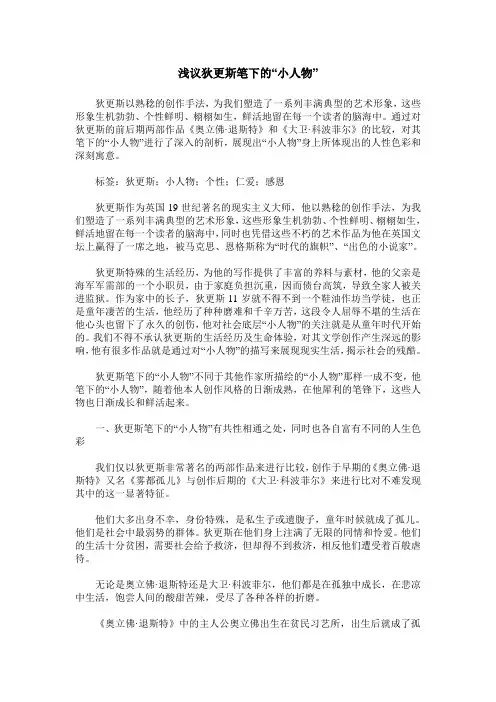
浅议狄更斯笔下的“小人物”狄更斯以熟稔的创作手法,为我们塑造了一系列丰满典型的艺术形象,这些形象生机勃勃、个性鲜明、栩栩如生,鲜活地留在每一个读者的脑海中。
通过对狄更斯的前后期两部作品《奥立佛·退斯特》和《大卫·科波菲尔》的比较,对其笔下的“小人物”进行了深入的剖析,展现出“小人物”身上所体现出的人性色彩和深刻寓意。
标签:狄更斯;小人物;个性;仁爱;感恩狄更斯作为英国19世纪著名的现实主义大师,他以熟稔的创作手法,为我们塑造了一系列丰满典型的艺术形象,这些形象生机勃勃、个性鲜明、栩栩如生,鲜活地留在每一个读者的脑海中,同时也凭借这些不朽的艺术作品为他在英国文坛上赢得了一席之地,被马克思、恩格斯称为“时代的旗帜”、“出色的小说家”。
狄更斯特殊的生活经历,为他的写作提供了丰富的养料与素材,他的父亲是海军军需部的一个小职员,由于家庭负担沉重,因而债台高筑,导致全家人被关进监狱。
作为家中的长子,狄更斯11岁就不得不到一个鞋油作坊当学徒,也正是童年凄苦的生活,他经历了种种磨难和千辛万苦,这段令人屈辱不堪的生活在他心头也留下了永久的创伤,他对社会底层“小人物”的关注就是从童年时代开始的。
我们不得不承认狄更斯的生活经历及生命体验,对其文学创作产生深远的影响,他有很多作品就是通过对“小人物”的描写来展现现实生活,揭示社会的残酷。
狄更斯笔下的“小人物”不同于其他作家所描绘的“小人物”那样一成不变,他笔下的“小人物”,随着他本人创作风格的日渐成熟,在他犀利的笔锋下,这些人物也日渐成长和鲜活起来。
一、狄更斯笔下的“小人物”有共性相通之处,同时也各自富有不同的人生色彩我们仅以狄更斯非常著名的两部作品来进行比较,创作于早期的《奥立佛·退斯特》又名《雾都孤儿》与创作后期的《大卫·科波菲尔》来进行比对不难发现其中的这一显著特征。
他们大多出身不幸,身份特殊,是私生子或遗腹子,童年时候就成了孤儿。
读书心得——《雾都孤儿》中的儿童形象研究迄今为止,东西方文学成功地塑造了许多儿童形象。
而十九世纪英国著名小说家查尔斯·狄更斯对国内外儿童形象塑造来说,意义非凡。
作为维多利亚时期下层阶级的一员,狄更斯深知当时儿童痛苦不堪的生活。
其笔下创造了许多诸如奥利弗·特维斯特,大卫·科波菲尔等的经典儿童形象,使狄更斯成为一位伟大的儿童形象塑造大师。
他有着敏锐的观察力与洞察力,笔法细腻,创造了一个又一个生动的儿童形象。
此外,他将儿童生活与社会环境紧密地联系在一起,幽默却又不失庄重的笔风令他的小说独具吸引力,耐人寻味。
狄更斯在《雾都孤儿》成功地塑造了不同的儿童形象:一是命运多舛的儿童形象;二是不向命运低头的儿童形象;三是真诚与感恩的儿童形象。
本文将分析《雾都孤儿》中的这三种儿童形象,以领略狄更斯儿童人物塑造的魅力。
一.命运多舛的儿童形象维多利亚时代,儿童问题,特别是孤儿问题,是当时较为严重的社会问题。
随着越来越多孤儿的出现,英国也出现了许多济贫院这类福利机构。
多数生活在济贫院的儿童遭受虐待,成为易受伤害的群体。
作为怀有正义感的现实主义作家,狄更斯用其敏锐的目光观察和捕捉那些命运多舛的儿童形象,将其艺术化,呈现在读者面前。
狄更斯在《雾都孤儿》中极其成功地塑造了孤儿奥利弗·特维斯特。
在济贫院长大的奥利弗不断遭受到非人类的对待。
冷血的班布尔先生给孩子们提供毫无营养的食物,以最低成本维持着这些孤儿的生活。
孩子们为多数时候是在饥饿、寒冷和恐惧中度过的。
其中一些孤儿因为饥饿、疾病或残酷的虐待而死去。
奥利弗代表大家想要更多的食物,结果遭到毒打,然后被卖给一个殡仪员做童工,饥寒交迫,孤独恐惧。
奥利弗淘到伦敦就落入贼窝,贼头费金试图把奥利弗训练成小偷。
在被布朗罗解救之后,本来可以有幸福的生活,但事与愿违,强盗又让他失去追求幸福的权利。
奥利弗优良品质和强盗的邪恶形成鲜明的对比,奥利弗的善良的显得更加珍贵,读者能够深深体会到他们幼小的心灵中有一道道深深的裂痕。
查尔斯·狄更斯作品中的儿童形象作者:陈怡洁来源:《牡丹》2017年第15期十九世纪,英国率先完成工业革命,成为头号资本主义工业强国,在全球占有很多殖民地,处于全盛时期。
与此同时,英国文学也得到了很好的发展。
作为英国最伟大的批判家查尔斯·狄更斯在塑造人物形象中有着自身独特的特点,主要表现在儿童形象的运用。
这些儿童不仅被赋予了狄更斯童年时代所受到的凌辱和伤害等,还被赋予了作家自身对未来发展的憧憬,因此这些被赋予儿童形象的作品不仅折射出作家的人道主义精神,而且成为其最具特色的创造内容。
本文从狄更斯作品以及个人发展方面进行了相关阐述,并深入分析了狄更斯作品中儿童形象特点。
作为公认的维多利亚女王时代最伟大的作家,狄更斯的许多作品人们都耳熟能详,并被人文雅士所共赏。
狄更斯在作品中塑造了大量儿童形象,其很好地应用了儿童素材,通过儿童的视角去表达自身的理想或者评判世界。
狄更斯的作品中有着非常浓厚的理想色彩,在叙述和描写中还有效地运用了大量文学方法,所以说狄更斯不仅是一名文学巨匠,而且是一盏在当时时代背景下的明灯。
一、狄更斯偏爱儿童形象的原因十九世纪,英国刚刚完成工业革命,而且此时也是英国走向资本主义市场的最为重要的时刻。
世界各地都有着庞大的日不落帝国的殖民地,可谓是英国最为鼎盛的时期。
与此同时,英国中产阶层联同工人阶层开展了各项变法运动,英国也因此将立法、选举等制度进行合理的改善,促进其资本主义市场的形成,资产阶级的地位有所提升。
但即使如此,英国经济高速发展的背景下,更多的社会问题逐渐暴露出来,尤其是在工业化的进程中,资产阶级和工人阶级也逐渐由以往的利益共享关系演变成由于经济利益分配不均而导致的对立关系。
机械化的工业发展导致工人逐渐由原来的主导地位变成机械的附庸,很多资本家为了自身经济利益最大化而剥削工人,甚至雇佣妇女或者童工这些廉价劳动力来降低成本。
更有甚者,资本家对于工人的生命安全不负责任,事故频发,尤其是对于儿童的影响最为恶劣,不仅影响了其生命安全,而且对于儿童的发展都有不良影响。
狄更斯作品中的儿童形象狄更斯的作品里,儿童形象真的是很有意思,也很值得咱们琢磨。
别看那些小小年纪的孩子,他们在书里可不是简单的配角。
拿《雾都孤儿》里的奥利弗来说吧,真是个让人又心疼又心生敬意的小家伙。
想想看,一个这么小的孩子,竟然敢提出“请给我点儿东西吃”,这敢作敢为的劲头,谁能不佩服?可是呢,奥利弗的生活可真不是你我想象中的童话,他是在最惨的环境里长大的,一直到仍然保持着对生活的希望,心底里总是藏着一股说不出的坚韧。
这么想,孩子本身的“天真”其实成了他最强大的武器。
像他那样坚韧的小孩,在当时的伦敦可不常见。
再说《双城记》中的小露西,哎呀,这个小姑娘简直就是一束光。
虽然她年纪不大,但却成了父亲和周围人心中的温暖。
露西的纯真,不是简单的“天真无邪”,而是那种让人一看到她,就觉得整个人都变得软乎乎的,心里很踏实。
她的角色,象征着无条件的爱和温暖,给那些疲惫的人一种治愈的力量。
反正我总是觉得,这种小孩子,哪怕眼里没有太多世故,却能在人群中散发出一种让你忍不住想去保护的光芒。
她的存在,让人想起了“有爱有未来”这种感觉,是真的,连她父亲那样一个坚硬的心,见到她都会柔软下来。
说到这里,别忘了还有那个忠诚的老管家贾维斯,他也是因为露西的原因,才不断被唤醒那颗早已沉睡的良知。
但是,狄更斯作品中的孩子并不全是那么可爱的角色,像《大卫·科波菲尔》里的大卫,虽说他的童年也是够悲惨的,但那个孩子身上有一股子韧劲,不服输。
你看,大卫从小失去了母亲,继父又对他不怎么样,结果他竟然一点也不气馁。
说实话,这孩子真是比很多大人都还要坚强。
即使如此,小大卫也不是一个死板的“勇敢男孩”,他身上有种不想让别人担心的俏皮劲儿,这种复杂的性格反而让他显得更真实。
尤其是他对朋友的忠诚,还有对未来的期待,真的让人感到,他好像总能在最黑暗的时候找到一线光明。
话说回来,狄更斯笔下的儿童角色,真是有点儿出乎意料的复杂。
你看他们虽然年纪小,但都能在艰难的环境中活得很有“存在感”。
收稿日期 :2000— 04— 20; 修改日期 :2000— 06— 27作者简介 :朱江 (1964—, 女 (汉族 , 上海市人 , 常州工学院讲师 1文章编号 :1008— 2654(2000 03— 0062— 03狄更斯笔下的两个儿童形象———谈奥列佛 . 退斯物特和大卫 . 科波菲尔朱江(常州工学院 , 江苏常州 213002摘要 :狄更斯的作品至今仍保持它们的价值 , , 特征。
关键词 :儿童形象 ; ; ; 批判现实主义中图法分类号 :G 642文献标识码 :A1描绘儿童形象的初衷童年的印象 , 往往是人一生中最深的印象。
童年生活对于人生往往是极有意义的 , 对于狄更斯来说 , 即为他将来的创作积累了素材。
凡是读过狄更斯作品的人都会发现 , 在几乎所有他的长篇小说中 , 儿童形象不仅为数众多 , 而且颇有特色 :有童年时代经历过各式各样考验的奥列佛 . 退斯特 ; 济贫院和贼窟里的儿童 ; 资产阶级教育的殉葬品的牺牲者艾斯黛拉 ; 不幸早逝的耐儿 ; 艰苦生活的过来人、迷雾中的寻求者大卫 . 科波菲尔。
狄更斯的童年经历过由小康坠入困顿的家庭变化 , 忍受过失学和当童工的痛苦。
但童年狄更斯是个天性好学、敏于观察的孩子。
他带着孩子天真的好奇心 , 通过自家的窗口 , 观察英帝国首都一些角落的风光、人物和发生的一切。
这些都成为作家以后选取素材的源泉。
在十九世纪维利亚时代 , 类似童年狄更斯的遭遇 , 比比皆是。
儿童的抚养、福利和教育 , 堪称当时普遍而严重的社会问题之一。
而当时一般的资产阶级作家对于儿童题材 , 尤其是贫苦儿童题材 , 不屑一顾。
在这样的情况下 , 狄更斯首屈一指 , 开拓一条塑造形象的新路。
狄更斯塑造的儿童形象 , 在大多数情况下 , 都是一些苦难而不幸的、不得不忍受严酷的贫苦生活 , 甚至或熬过在他人看来力不胜任的道德考验。
对他们来说 , 世界的残酷的现实的确感受到了 ! 他们虽然具有儿童时代的形体 , 却没有儿童时代的轻快的心、欢畅的笑和发亮的眼睛 !正是这些儿童的不幸遭遇 , 早熟畸形的笔下的儿童世界的惨淡色调。
狄更斯小说中的儿童形象分析摘要出生于1812年的查尔斯·狄更斯,是英国19世纪杰出的小说家。
在狄更斯的创作中,他倾注了极大的精力创造儿童形象,并取得了独创性的成就。
他所创造的儿童形象大致可分为尝尽人生磨难的儿童、悲惨命运的儿童以及理想化的儿童三类。
狄更斯对儿童充满了同情与关注,是想呼吁社会关心儿童的成长和需要,旨在引导社会向着美好的方面发展。
关键词:狄更斯小说儿童形象命运中图分类号:i106文献标识码:a查尔斯·狄更斯一生描绘了九十多个儿童形象,儿童形象在他的创作中取得了独创性的成就。
如《奥立弗·退斯特》中的小蒙克斯、诺亚·克雷、南茜;《尼古拉斯·尼克尔贝》中的小瓦克福·斯奎尔斯;《老古玩店》中的耐儿、小雅各;《马丁·朱述尔维特》中的苏菲亚;《大卫·科波菲尔》中的小大卫、汤米·特拉德尔斯;《荒凉山庄》中的小埃丝特·萨默森、《双城记》中的小露西、小查尔斯;《艾德温·德鲁德疑案》中的小罗莎·布德等。
这些儿童形象大致归为饱经人生磨难的儿童、悲惨命运的儿童、理想化的儿童三类。
一饱经人生磨难的儿童形象这类儿童形象包括大卫·科波菲尔、弗洛伦丝、匹普与保罗等。
狄更斯通过对自身一些相似经历的描写,深刻体现了他对孤苦儿童的倾心的关爱与怜惜。
狄更斯在三十八岁的时候创作了《大卫·科波菲尔》,由于童年做童工的可怕经历,狄更斯以一种近乎宗教的畏惧心来看待自己的童年,他把这些回想描写出来仿佛是一种解脱。
在他的小说《大卫·科波菲尔》中,儿童大卫·科波菲尔是个遗腹子,但由于母亲与佣人佩戈蒂对他的关爱,他在孩提时代是非常幸福的,但自母亲与吝啬、残忍的摩德斯通先生再婚后,小大卫就不得不跟快乐再见了,他的家庭从此失去了祥和与幸福。
他清楚地记得这种悲惨生活开始的时间:“灰蒙蒙的下午,天气寒冷,预示着大雨即将到来”。
在继父打他时,柔弱无助的母亲神情绝望、面目凄惨地在一旁看着,佩戈蒂除了暗自垂泪也无能为力。
终于,受尽精神折磨的母亲去世了,而佩戈蒂也被他的继父解雇了,大卫最为凄凉的日子真正开始了。
他陷入了孤苦无依的境地,并在十岁时被送去做了一名童工。
他这个举目无亲、衣衫褴褛的孩子,每天“对着光亮检查这些瓶子……空瓶子洗完,便给装酒的瓶子贴标签,或将完工的瓶子装箱”。
他只能靠这份粗活来养活自己,在无法忍受的情况下,大卫从摩德斯通·格林百货栈逃了出来,可行李和钱包在途中还被别人抢了,他一路上吃尽苦头走到姨婆贝西小姐那儿,这才脱离了苦海。
童年的印象,往往是人一生中最深的印象。
童年体验包括童年的各种感受、知识、记忆、意志等,它带有情绪色彩,是一个人在童年生活经历中所获得的心理体验的总和,并在每个人的一生中占有非常大的分量。
而对作家来说,作家的体验生成与他的童年体验有着很大联系的。
对狄更斯而言,童年的体验为他创作带来了丰富的素材,这种体验在他心灵上留下了深刻的印痕,它造就了作家的心理意向,并作为一种基调渗透在作品之中。
狄更斯对儿童的同情就始于此。
在分析《大卫·科波菲尔》时,孤独无助的小大卫就是作家当年心情的真实写照。
在《大卫·科波菲尔》这部作品里,记录了主人公“心灵成长”的故事。
大卫·科波菲尔的塑造倾注了狄更斯全部心血,作者通过大卫悲欢离合的一生,表现了一个小人物在社会中寻找出路的痛苦历程,善良纯洁、奋发向上的大卫最终找到了幸福,一个丰满的人物形象也达到了精神上的幸福与和谐。
狄更斯在许多作品中都敏感地刻画出一些情感缺失的儿童形象,由此透露出了他的矛盾:充满了喜剧色彩的狄更斯,与性格内向的狄更斯。
作家在《荒凉山庄》中,描写了杰利比家的孩子们得不到父母半点的关心与照顾。
作家嘲弄、批判那失职的母亲杰利比太太的事业是“望远镜里的慈善事业”,她把全部精力都用在了非洲事务上,却对自己的孩子没有尽到人最基本的责任,任其自生自灭。
他们的父亲在家里也深受其苦、意志消沉,没有任何地位,对孩子们有心无力。
他们的大女儿凯蒂说:“我妈为人父母的责任全给了社会和非洲了!”而对孩子不负责任的杰利比太太,有着作家母亲的影子。
童年的经历让狄更斯从小渴望幸福家庭。
他认为完美的家庭应有一个当家做主的、慈祥正直的父亲,操持家务的贤良母亲和身心健康的可爱孩子构成。
三者中任何一部分不具备都是不完美的家庭。
在《董贝父子》中,由于董贝先生重男轻女,美丽可爱的弗洛伦丝被父亲厌弃,他认为只有儿子保罗才能接管他的商号,至于女儿对董贝公司没有意义,相当于“不能投资的一块赝币”。
在他看来金钱是至高无上的,由于弗洛伦丝和小保罗两姐弟亲密无间,使弗洛伦丝成了他所讨厌的对象。
这个人见人爱的富贵家庭的女孩只有孤独与卑怯,她的遭遇令人同情,处境使人心酸。
而对于弟弟保罗,虽然董贝先生把全部情感都倾注在他身上,但他只能以自己的方式去爱,是一种异化了的感情,儿子是无权过快乐童年的儿童,他只把保罗当作继承人来对待。
董贝对儿子的感情独占,他因为奶娘波莉·图德尔擅自把保罗好心带回家而将她打发掉,致使小保罗从此体弱多病。
他把幼小的保罗送往以填塞知识著称的布灵博士学院,可怜的小保罗脑子里被塞满了希腊罗马古董,最终,小保罗的性格变得内向、忧郁、孤僻,他唯一感到的快乐就是和姐姐在一起。
最后,由于他越来越虚弱的身体,夭折了。
作家通过小保罗的死暗示人们,是董贝先生促成了儿子的死亡。
小保罗临死前,对弗洛伦丝说:河水流得更快了,他已听到海浪的声音,他想休息了。
狄更斯刻画的这些儿童形象,他们或无父无母,从生活上或是精神上存在着不完整。
他们童年命运虽有坎坷,但由于他们有其他亲人在,还是幸福的;但是由于享受不到家庭的温暖,他们是精神上的孤儿。
这与作家自己的童年生活与经历相关。
他将自己那艰难的童年生活,以及难以忘怀的感情融入其中,以引起读者的共鸣,使所有读者能分享他的悲欢。
此外,狄更斯还通过学校对儿童的迫害,表现了他对当时教育体制弊端的深切观察与批判,且充满了忧虑。
他在《董贝父子》、《大卫·科波菲尔》等书中所描写的那些学校,令人毛骨悚然。
在这里,童年的轻快变成了老年的迟钝,童年的希望在成长中枯萎了。
狄更斯通过对这些学校的揭露,来极力抗议那些侵犯儿童权利的暴行。
如《董贝父子》中,尽管小保罗的奶娘波莉·图德尔家的生活条件并不怎么好,但五个孩子非常活泼健康,一家子幸福安康。
但受董贝先生的指示,波莉·图德尔的长子比勒被送进了一所磨工学校。
从此,小比勒的生活彻底改变。
校长用那根残酷的拐杖经常打他,这使小比勒感到厌烦,脾气变得暴躁,学会了使坏欺负别人,彻底变成了英国学校“打骂教育”的牺牲品。
狄更斯将这样的弊端摆在人们的面前,希望全社会能关心孩子的教育,重视孩子们的成长。
二悲惨命运的儿童形象狄更斯一生目睹了英国的巨变,其写作风格是在特定的历史背景下形成的。
19世纪30年代至40年代,英国成为最发达的资本主义国家。
资本主义新制度的建立给劳动群众带来剧烈的阵痛,暴露出其本质弊端,随着工商业的迅猛发展,产生了许多新的社会问题。
狄更斯以无情的笔触,通过济贫院、贫民窟,详细地描述了贫穷、疾病和罪恶的恐怖,表现了儿童的悲惨处境。
在小说《双城记》中,作家为了表现圣·安东尼贫民窟的凄惨情景,他写道:“饥饿到处横行……饥饿刻在面包师的每一小块坏面包上,每一块死狗肉之中……饥饿在每碗薄粥之中化为用半点油炒过的马铃薯碎末。
”读者读了之后,仿佛看到了贫民窟里的污秽恶臭,人们衣不蔽体、面黄肌瘦的悲惨情形,令人产生强烈的同情。
作家在《荒凉山庄》中,描写了一个叫“乔”的可怜孤儿在贫民窟“汤姆独院”中的生长:“这些破房子也住满了倒霉的家伙,他们在透风漏雨的地方缩成一团睡觉……到处撒下罪恶的种子……”“可怜的乔”是受压迫、被剥削人民的总代表,是当时英国资本主义的牺牲品。
这个出入“托姆独院”贫民窟的孩子,从出世起就不知道父母之爱,没有朋友,不知道人间温饱,连自己的名字都不会拼写,终日以饥饿与寒冷为伴侣。
由于偶然,他结识了德洛克夫人昔日的情人——霍顿上尉,他现在沦落街头,靠抄写诉讼文件糊口,并与“可怜的乔”分享。
但却给“可怜的乔”带来了灾难,由于乔无意中知道了德洛克夫人的秘密,于是成了众矢之的,被人追踪拦截,驱赶。
最终他受尽折磨,死于瘟病。
乔的死向全社会发出了控诉,成为狄更斯小说中的名段。
和贫民窟一样,济贫院是下层人民困苦生活的体现。
作家关于济贫院的出色描写,真实地反映了被压迫者的不幸遭遇,讽刺揭露了资产阶级统治者的专制暴戾。
在《奥立弗·退斯特》中,小说一开始就辛辣地讽刺了官方的慈善机构所——“济贫院”的不人道的行为。
在贫民院,孤儿们实在无法忍受饥饿的折磨,决定用抽签的办法向大师傅要求添粥。
当奥立弗·退斯特中签后,他拿着碗和汤匙走到大师傅跟前,不顾一切地说:“对不起,先生,我还要。
”但他的要求却遭到了禁闭的惩罚。
奥立弗的处境是所有受压迫、忍饥挨饿孩子们的真实写照,狄更斯就这样形象化地描绘了食不果腹、饥肠辘辘的济贫院孩子们,他们是当时英国社会的反常现象的缩影。
奥立弗添粥的要求隐约表示出一定的抗议,作品将天真幼稚的反抗精神和英国制度的可悲可笑融为一体,其复杂的感情令人读后回味无穷,使奥立弗的“再添一点儿”成为英国小说中的名句。
狄更斯在《奥立弗·退斯特》中,抗议英国法律不顾穷人和他们的孩子,这部小说在当时形成非常有力的舆论,促使政府下决心予以改革。
三理想化的儿童形象狄更斯小说中“理想化”了的儿童形象描绘的是那些历经磨难却依然保存着善良、纯真的天性的孩子,作者用这些理想化的形象表达了他对人性善的美好理想。
如《大卫·科波菲尔》中的阿格尼丝、《奥立弗·退斯特》中的主人公奥立弗,充分表现出了作家对美好人生的追求。
《大卫·科波菲尔》中的阿格尼丝,她的脸上带着安详的神态、身上蕴含着一种恬静、温婉。
阿格尼丝的父亲是个律师,有一个律师事务所,阿格尼丝的母亲去世后,他萎靡不振,小女儿还是他的精神支柱。
阿格尼丝小小年纪就成了父亲的“小管家”。
她性情温顺、心地善良,给大卫的体贴与友善让大卫始终觉得“哪里有阿格尼丝,哪里就有真、善、美……”她象征着一种美好的力量,在任何环境下都纯洁友善、传播爱的温馨。
尽管阿格尼丝承担着生活的重力,身边有对她虎视眈眈、阴险狡诈的尤利亚·希普对,但她健康地成长,最终得到了幸福。
而《奥立弗·退斯特》中的奥立弗是出生在济贫院的孤儿,他不知道自己的父亲是谁,他在济贫院的寄养所里被“养育”了九年,由于犯下了要求添粥的罪过被送到了棺材店里当学徒。